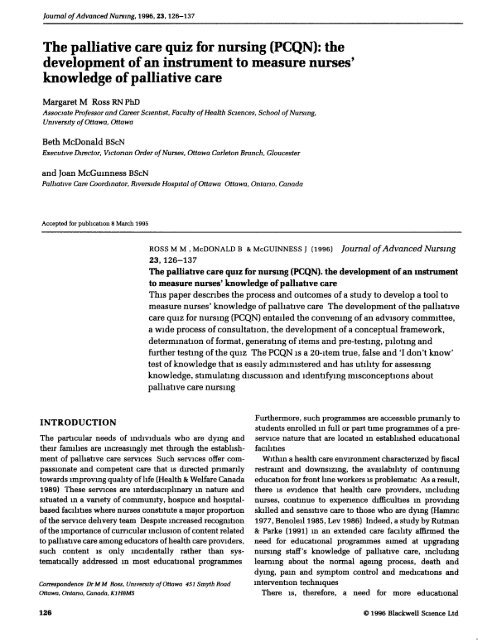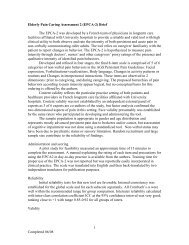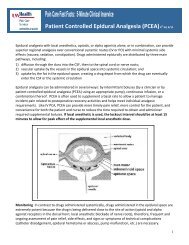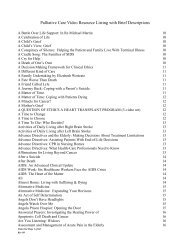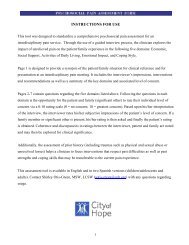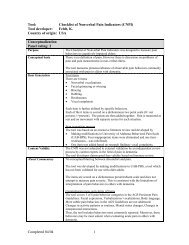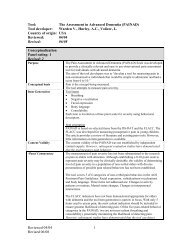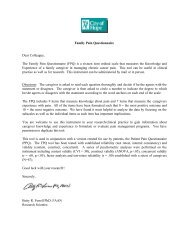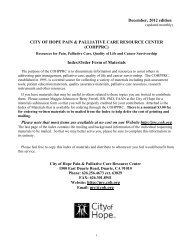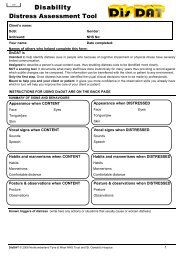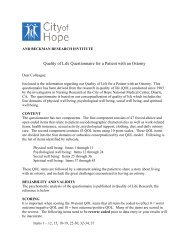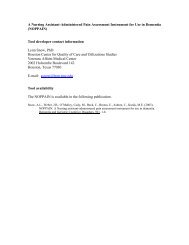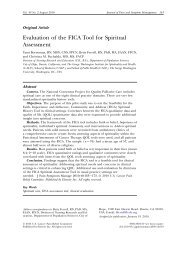The palliative care quiz for nursing (PCQN): the development of an ...
The palliative care quiz for nursing (PCQN): the development of an ...
The palliative care quiz for nursing (PCQN): the development of an ...
You also want an ePaper? Increase the reach of your titles
YUMPU automatically turns print PDFs into web optimized ePapers that Google loves.
Palliative aire <strong>quiz</strong>Table 2 R<strong>an</strong>k order <strong>of</strong> itemsmissed by group (lowernumbers indicate mostfrequently missed items)ItemR<strong>an</strong>k orderGenencstudentsPost-RNstudentsRegisterednursesRegisteredpracUcal nursesWdfP1234567891011121314197811125101418115324185101711320161941526116125171031920146112712068171321918153145410 1750 30 5515201289161761387189127181714131619994102016131511have at <strong>the</strong>ir hfuids a method <strong>of</strong> measuring <strong>the</strong> leammgneeds <strong>of</strong> providers <strong>of</strong> <strong>care</strong>, providing instruction to learners,<strong>an</strong>d determining <strong>the</strong> outcomes <strong>of</strong> educational programmesaimed at increasing knowledge <strong>of</strong> <strong>palliative</strong><strong>care</strong> practice<strong>The</strong> process used m <strong>the</strong> <strong>development</strong> <strong>of</strong> <strong>the</strong> <strong>PCQN</strong> wasparticipatory, consultative <strong>an</strong>d comprehensive in nature<strong>an</strong>d involved those most knowledgeable about <strong>palliative</strong><strong>care</strong> <strong>nursing</strong> at all phases <strong>of</strong> <strong>development</strong> Such a processmay have utility <strong>for</strong> o<strong>the</strong>r settings <strong>an</strong>d content areas hyincreasing <strong>the</strong> likelihood that knowledge assessment toolsreflect <strong>the</strong> content area to he tested Prominent features <strong>of</strong>this process are (a) <strong>the</strong> convenmg <strong>of</strong> <strong>an</strong> advisory committeeto provide direction at all phases <strong>of</strong> <strong>development</strong>,(h) a wide process <strong>of</strong> consultation beyond <strong>the</strong> advisorygroup, (c) <strong>the</strong> <strong>development</strong> <strong>of</strong> a conceptual framework,(d) determination <strong>of</strong> <strong>for</strong>mat, (e) <strong>the</strong> <strong>development</strong> <strong>of</strong> a pool<strong>of</strong> Items, (f ) pre-testing <strong>of</strong> items, (g) piloting <strong>of</strong> <strong>the</strong> items,<strong>an</strong>d (h) fur<strong>the</strong>r testing <strong>of</strong> items<strong>The</strong> <strong>palliative</strong> <strong>care</strong> <strong>quiz</strong> <strong>for</strong> <strong>nursing</strong> is a 20-item true,false <strong>an</strong>d don't know test <strong>of</strong> knowledge that takes approximately20 minutes to admmister <strong>an</strong>d is quickly <strong>an</strong>d easilyscored It was developed with several purposes m mmdFirst, it was mtended to measure knowledge <strong>of</strong> <strong>palliative</strong><strong>care</strong> <strong>nursing</strong> Respondents varied m <strong>the</strong>ir responses to <strong>the</strong><strong>PCQN</strong> according to level <strong>of</strong> education <strong>an</strong>d expenenceThose with higher levels <strong>of</strong> education <strong>an</strong>d more years <strong>of</strong>expenence achieved <strong>the</strong> highest scores m response to <strong>the</strong><strong>PCQN</strong> In addition, those with specialized trammg in <strong>palliative</strong><strong>care</strong> achieved higher scores th<strong>an</strong> those without suchtraimng <strong>The</strong>se findings provide evidence <strong>of</strong> <strong>the</strong> validity<strong>of</strong> <strong>the</strong> <strong>PCQN</strong> as a measure <strong>of</strong> knowledgeSecondly, <strong>the</strong> <strong>PCQN</strong> was developed to stimulate discussionabout <strong>palliative</strong> <strong>care</strong> <strong>nursing</strong> Though admittedlysubjective, assessment <strong>of</strong> <strong>the</strong> <strong>quiz</strong> <strong>for</strong> stimulating groupdiscussion, at least among nurses <strong>an</strong>d students <strong>of</strong> <strong>nursing</strong>,was positive <strong>The</strong> <strong>PCQN</strong> was administered to genenc students,post-RN students, registered nurses <strong>an</strong>d registeredpractical nurses Particip<strong>an</strong>ts responded favourahly totaking <strong>the</strong> <strong>quiz</strong> <strong>an</strong>d were acutely interested m <strong>the</strong>correct <strong>an</strong>swers Although not qu<strong>an</strong>tified, <strong>the</strong>ir verhatimresponses regarding <strong>the</strong> usefulness <strong>of</strong> <strong>the</strong> <strong>quiz</strong> suggest that<strong>the</strong> <strong>PCQN</strong> IS thought-provoking <strong>an</strong>d eye-openmg Fur<strong>the</strong>rtesting, however, is required to determine whe<strong>the</strong>r use <strong>of</strong><strong>the</strong> <strong>quiz</strong> prior to a penod <strong>of</strong> instruction would result ingreater willingness to contnhute to discussion <strong>an</strong>d a generedheightened receptivity to <strong>the</strong> instruction that followsThirdly, <strong>the</strong> <strong>PCQN</strong> was intended to identify misconceptionsahout <strong>palliative</strong> <strong>care</strong> <strong>nursing</strong> Although <strong>the</strong>re weredifferences among groups with respect to misconceptions,<strong>the</strong>re were also notahle simil<strong>an</strong>ties One such example liesm <strong>the</strong> simil<strong>an</strong>ty among groups with respect to <strong>the</strong> misconceptionthat <strong>palliative</strong> <strong>care</strong> is not compatible with <strong>the</strong> provision<strong>of</strong> aggressive treatment This was <strong>the</strong> second mostfrequent misconception among registered nurses <strong>an</strong>dpost-RN students, <strong>the</strong> third among genenc students <strong>an</strong>d<strong>the</strong> fifth among registered practical nurses <strong>The</strong> qiuz c<strong>an</strong>,<strong>the</strong>re<strong>for</strong>e, serve as <strong>an</strong> educational needs assessment tool© 1996 Blackwell Science Ltd, Journal <strong>of</strong> Adv<strong>an</strong>ced Nursing, 23, 126-137 133
M M Ross et alby providmg data about <strong>the</strong> level <strong>of</strong> knowledge alreadypossessed by potential particip<strong>an</strong>ts <strong>an</strong>d allow educators t<strong>of</strong>ocus instruction on <strong>the</strong> issues <strong>of</strong> greatest needThis finding also suggests that educational programmesin <strong>palliative</strong> <strong>care</strong> should be targeted <strong>for</strong> specific audienceswith specific leammg needs Never<strong>the</strong>less, given <strong>the</strong> simil<strong>an</strong>tiesm misconceptions across groups, <strong>the</strong>re is a need<strong>for</strong> all levels <strong>of</strong> nurses to upgrade <strong>the</strong>ir level <strong>of</strong> knowledge<strong>of</strong> <strong>the</strong> concepts <strong>of</strong> <strong>palliative</strong> <strong>care</strong> <strong>an</strong>d <strong>the</strong>ir application mclmical practice <strong>The</strong> <strong>PCQN</strong> c<strong>an</strong> be useful m identifying<strong>an</strong>d correcting <strong>the</strong>ir misconceptions about <strong>palliative</strong> <strong>care</strong>nursmgFinally, <strong>the</strong> <strong>quiz</strong> c<strong>an</strong> also be used as a tool <strong>for</strong> instructionitself or as <strong>the</strong> primary focus <strong>for</strong> a period <strong>of</strong> instructionwithout <strong>an</strong>y pre- or post-testing In this way, <strong>the</strong> <strong>PCQN</strong>c<strong>an</strong> be used to encourage students to be active particip<strong>an</strong>tsm <strong>the</strong>ir learning by stimulating discussion <strong>of</strong> issues relatedto <strong>palliative</strong> <strong>care</strong> nursmgLimitationsDespite Its potential use, <strong>the</strong> <strong>PCQN</strong> has several limitationsIt IS not designed to provide a comprehensive assessment<strong>of</strong> knowledge <strong>of</strong> <strong>palliative</strong> <strong>care</strong> or <strong>palliative</strong> <strong>care</strong> <strong>nursing</strong>Brevify <strong>an</strong>d simplicify <strong>of</strong> administration <strong>an</strong>d scoringmakes <strong>the</strong> <strong>quiz</strong> useful <strong>for</strong> m<strong>an</strong>y educators but limits itsvalue vnth respect to <strong>the</strong> comprehensive assessment <strong>of</strong>higher levels <strong>of</strong> knowledge associated with expertise in<strong>palliative</strong> <strong>care</strong> practice <strong>The</strong>re<strong>for</strong>e, it is not appropriate <strong>for</strong><strong>the</strong> assessment <strong>of</strong> knowledge levels <strong>of</strong> expert practitionersRa<strong>the</strong>r, <strong>the</strong> <strong>quiz</strong> focuses on <strong>the</strong> basic type <strong>of</strong> in<strong>for</strong>mationrequired <strong>for</strong> entry to practice that would normally be foundm introductory courses, workshops <strong>an</strong>d programmes<strong>The</strong> predictive validify <strong>of</strong> <strong>the</strong> <strong>quiz</strong> has not been assessed<strong>an</strong>d <strong>the</strong>re<strong>for</strong>e it is not known to what degree knowledgeas measured hy <strong>the</strong> <strong>PCQN</strong> is related to actual behaviourFur<strong>the</strong>r research should examine this issue as well as <strong>the</strong>issue <strong>of</strong> whe<strong>the</strong>r <strong>the</strong> <strong>quiz</strong> is useful <strong>for</strong> assessing ch<strong>an</strong>ge inknowledge resulting from instruction In addition, <strong>the</strong>sample with whom <strong>the</strong> <strong>quiz</strong> was developed was not fullyrepresentative <strong>of</strong> <strong>the</strong> broad r<strong>an</strong>ge <strong>of</strong> nursmg personnel withwhom <strong>the</strong> qmz might eventually be used Pilot testing witha more representative sample <strong>of</strong> registered nurses,registered practical nurses <strong>an</strong>d o<strong>the</strong>r categones <strong>of</strong> nursmgpersonnel, would be wise to assure that <strong>the</strong> reading levels<strong>an</strong>d content associated with <strong>the</strong> <strong>PCQN</strong> are appropnateAlthough <strong>the</strong> psychometnc properties <strong>of</strong> <strong>the</strong> <strong>PCQN</strong>could be improved by elimmating some <strong>of</strong> <strong>the</strong> items,especially those with <strong>an</strong> item difficulfy <strong>of</strong> over 0 80 <strong>for</strong>registered nurses, a decision was made to retain <strong>the</strong>seItems m order to add to <strong>the</strong> edumetnc properties <strong>of</strong> <strong>the</strong><strong>quiz</strong> <strong>The</strong> <strong>quiz</strong> is designed to yield measurements that aredirectly interpretable m terms <strong>of</strong> specific per<strong>for</strong>m<strong>an</strong>cest<strong>an</strong>dards (Glaser & Mitko 1971) <strong>The</strong> specified per<strong>for</strong>m<strong>an</strong>cest<strong>an</strong>dard m this case is <strong>the</strong> abilify to <strong>an</strong>swer all 20items correctly Given this st<strong>an</strong>dard, it is not crucial thatall Items have a high discnmmatory power or high itemto total correlation An mdividual who c<strong>an</strong> <strong>an</strong>swer <strong>the</strong>item correctly has more in<strong>for</strong>mation th<strong>an</strong> <strong>an</strong> mdividualwho c<strong>an</strong>notO<strong>the</strong>r edumetnc properties include <strong>the</strong> abilify to identifymisconceptions <strong>an</strong>d to stimulate discussion about <strong>palliative</strong><strong>care</strong> nursmg <strong>The</strong>se properties would not have beenimproved by attending too stnngently to <strong>the</strong> entena <strong>of</strong>item difficulty <strong>an</strong>d item discrimination Such entena,while eentral to <strong>the</strong> psyehometnc properties <strong>of</strong> a test, arenot necess<strong>an</strong>ly central to its edumetnc properties Thus,by retaining items that have not attained optimal psychometncproperties <strong>for</strong> one group <strong>of</strong> respondents, but thatare conceptually import<strong>an</strong>t, it is expected that <strong>the</strong> edumetncproperties <strong>of</strong> <strong>the</strong> <strong>quiz</strong> are enh<strong>an</strong>cedConclusionIn conclusion, <strong>the</strong> <strong>palliative</strong> <strong>care</strong> <strong>quiz</strong> <strong>for</strong> nursmg appearsto be a promising tool with utility <strong>for</strong> assessing knowledge,stimulating discussion <strong>an</strong>d identifying misconceptions<strong>The</strong> <strong>quiz</strong> c<strong>an</strong> be used <strong>for</strong> assessing learning needs <strong>an</strong>d maybe useful as a teachmg tool <strong>an</strong>d <strong>for</strong> contnbutmg to <strong>the</strong>evaluation <strong>of</strong> educational programmes related to <strong>the</strong> provision<strong>of</strong> <strong>palliative</strong> <strong>care</strong> <strong>The</strong> <strong>development</strong> <strong>of</strong> <strong>the</strong> <strong>palliative</strong><strong>care</strong> <strong>quiz</strong> <strong>for</strong> nursmg helps to fill <strong>the</strong> gap m instrumentationavailable <strong>for</strong> teaching <strong>an</strong>d research initiatives aimedat improving <strong>the</strong> qualify <strong>of</strong> education received by health<strong>care</strong> providers <strong>an</strong>d ultimately <strong>the</strong> qualify <strong>of</strong> <strong>palliative</strong> <strong>care</strong>received by those who are dying <strong>an</strong>d <strong>the</strong>ir familiesAcknowledgements<strong>The</strong> Ottawa Carleton Regional Palliative Care Associationprovided <strong>the</strong> major funding <strong>for</strong> this project KnollPharmaceutics, <strong>the</strong> Victon<strong>an</strong> Order <strong>of</strong> Nurses (OttawaCarleton Br<strong>an</strong>ch), <strong>the</strong> Ottawa Carleton Regional C<strong>an</strong>cerCentre <strong>an</strong>d <strong>the</strong> Riverside Hospitid provided additionalfundmg A Community Researcher Award from <strong>the</strong>National Health <strong>an</strong>d Research Development Programme<strong>an</strong>d a Mimstry <strong>of</strong> Health <strong>of</strong> Ont<strong>an</strong>o Career Scientist Awardto Dr Margaret M Ross also provided assist<strong>an</strong>ce with<strong>the</strong> conduct <strong>of</strong> <strong>the</strong> study <strong>an</strong>d <strong>the</strong> preparation <strong>of</strong> thism<strong>an</strong>uscriptReferencesBenner P (1984) From Novice to Expert Excellence <strong>an</strong>d Powerin Clinical Nursing Practice Addison-Wesley, Menlo Park,Gali<strong>for</strong>maBenoliel J Q (1985) Loss <strong>an</strong>d terminal illness Nursing Climes <strong>of</strong>North Amenca 20(2), 439-448Gourtenay B G & Weidem<strong>an</strong> G (1985) <strong>The</strong> effects <strong>of</strong> a 'don't know'134 © 1996 BlackweU Science Ltd, Journal <strong>of</strong> Adv<strong>an</strong>ced Nursmg, 23, 126—137
Palliative caw <strong>quiz</strong>Bowers B (1987) Intergeneration <strong>care</strong>givmg adult <strong>care</strong>givers <strong>an</strong>d<strong>the</strong>n: aging parents Adv<strong>an</strong>ces m Nursirtg Science 9(2), 20-31Bowers B (1988) Family perceptions <strong>of</strong> <strong>care</strong> in a <strong>nursing</strong> home<strong>The</strong> Gerontologist 28(3), 361-368Coyle N , Adelhardt J , Foely D & Portenoy R (1990) Character <strong>of</strong>terminal illness in <strong>the</strong> adv<strong>an</strong>ced c<strong>an</strong>cer patient pain <strong>an</strong>d o<strong>the</strong>rsymptoms dunng <strong>the</strong> last four weeks <strong>of</strong> life foumal <strong>of</strong> Pam<strong>an</strong>d Symptom M<strong>an</strong>agement 5(2), 83-93Cr<strong>an</strong>e R , Wilson P & Behrens G (1990) Pain control m hospicehome <strong>care</strong> m<strong>an</strong>agement guidelines Amenc<strong>an</strong> foumal <strong>of</strong> Hospice<strong>an</strong>d Palliative Care 7(6), 39-42Degner L & Berkwell D (1991) Programmed instruchon non<strong>an</strong>algesicapproaches to pam control C<strong>an</strong>cer Nursing 14(2),105-111Dicks B (1990) Programmed instruction c<strong>an</strong>cer pain C<strong>an</strong>cerNursing 13(4), 256-261Doyle D , H<strong>an</strong>ks G & MacDonald N (1993) Ox<strong>for</strong>d Textbook <strong>of</strong>Palliative Care Medicine Ox<strong>for</strong>d Medical Publishers, LondonFainsmger R & Bmera E (1991) Hypodermoclysis (HOC) <strong>for</strong>symptom control versus <strong>the</strong> Edmonton injector (El) foumal <strong>of</strong>Palliative Care 7(4), 5-8Growe S J (1991) Who Cares'' <strong>The</strong> Crisis m C<strong>an</strong>adi<strong>an</strong> NursingMcClell<strong>an</strong>d & Stewart, TorontoHaviley C , Gagnon J , MacLe<strong>an</strong> R et al (1992) Pharmacologiem<strong>an</strong>agement <strong>of</strong> c<strong>an</strong>cer pam a guide <strong>for</strong> <strong>the</strong> health <strong>care</strong> pr<strong>of</strong>essionalC<strong>an</strong>cer Nursing 15{5], 331-346Health <strong>an</strong>d Welfare C<strong>an</strong>ada (1989) Palliative Care ServicesGuidebnes HMlth Service Directorate, Subcomnuttee onInstitutional Program Guidelines, Ministry <strong>of</strong> Supplies <strong>an</strong>dServices, OttawaKaye L (1990) Notes on Symptom Control m Hospice <strong>an</strong>dPalliative Care (revised 1st edn, USA version) HospiceEducation Institute, Essex, ConnecticutMams P (1974) Loss <strong>an</strong>d Ch<strong>an</strong>ge Routledge & Keg<strong>an</strong> Paul,LondonMcCaffery M , Ferrel B , O'Neill-Page E & Lester M (1990) Nurses'knowledge <strong>of</strong> opioid <strong>an</strong>algesic drugs <strong>an</strong>d psychologicaldependence C<strong>an</strong>cer Nursing 13(1), 21-27McCaffery M &BeebeA (1990) Pajn Clinical M<strong>an</strong>ual <strong>for</strong> NursingPractice Moshy, St LouisMcHomey C & Mor V (1988) Predictors <strong>of</strong> bereavementdepression <strong>an</strong>d its health services consequences Medical Care26(9), 882-893MacDonald N (1991) <strong>The</strong> C<strong>an</strong>adi<strong>an</strong> Palliative Gare Cumculum<strong>The</strong> C<strong>an</strong>adi<strong>an</strong> Committee on Palliative Care Education <strong>The</strong>C<strong>an</strong>adi<strong>an</strong> Palliative Care Association, OttawaOncology Nursing Society (1990) Position Paper on Pain ControlSPROSS 17(4), 597-614Twycross R & Lack S (1983) Symptom Gontrol in Far Adv<strong>an</strong>cedC<strong>an</strong>cer Pam Relief Pitm<strong>an</strong>, London© 1996 Blackwell Science Ltd, foumal <strong>of</strong> Adv<strong>an</strong>ced Nursing, 23, 126-137 137


